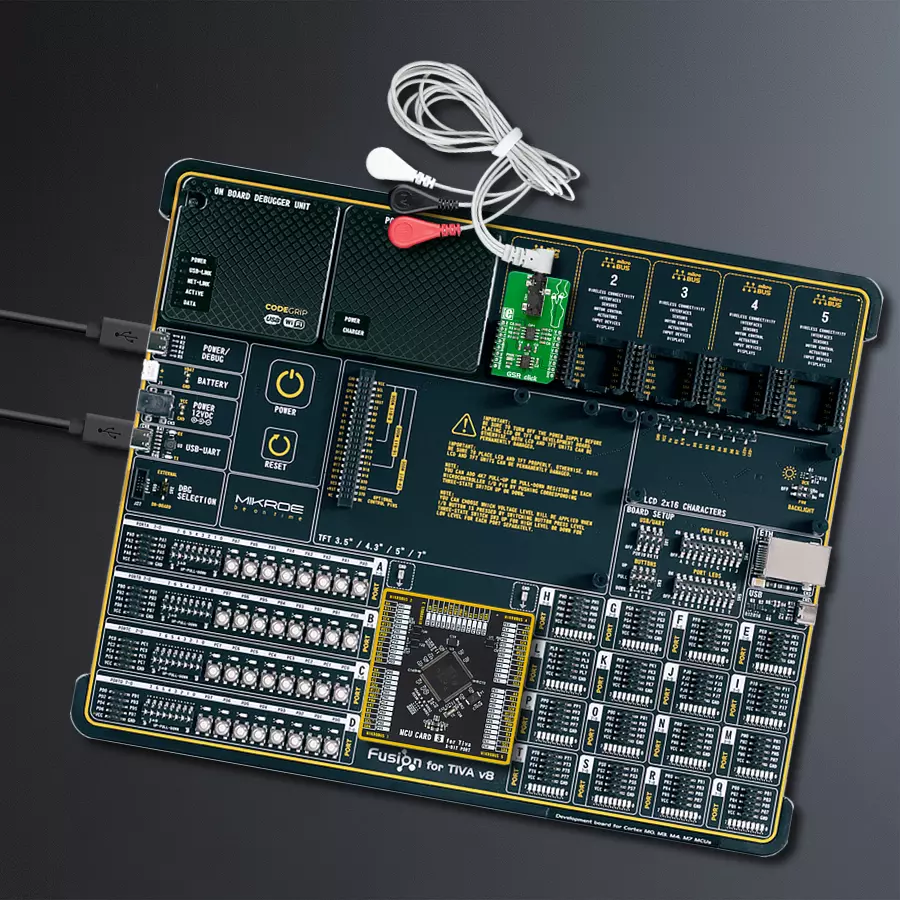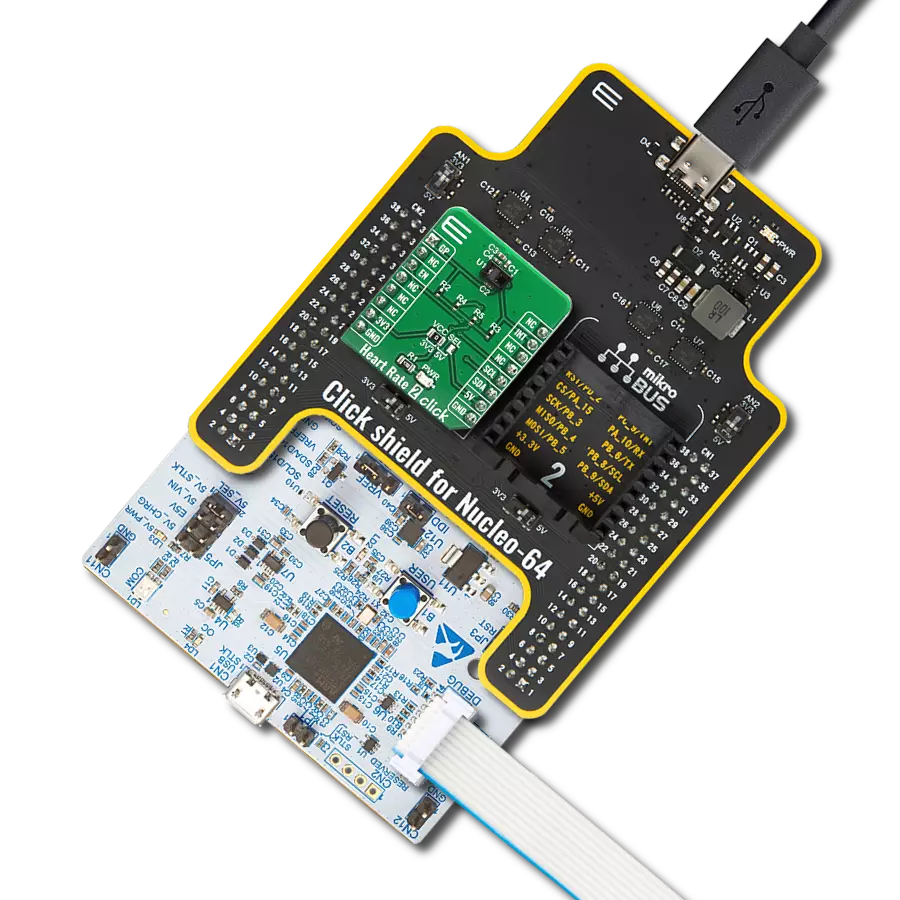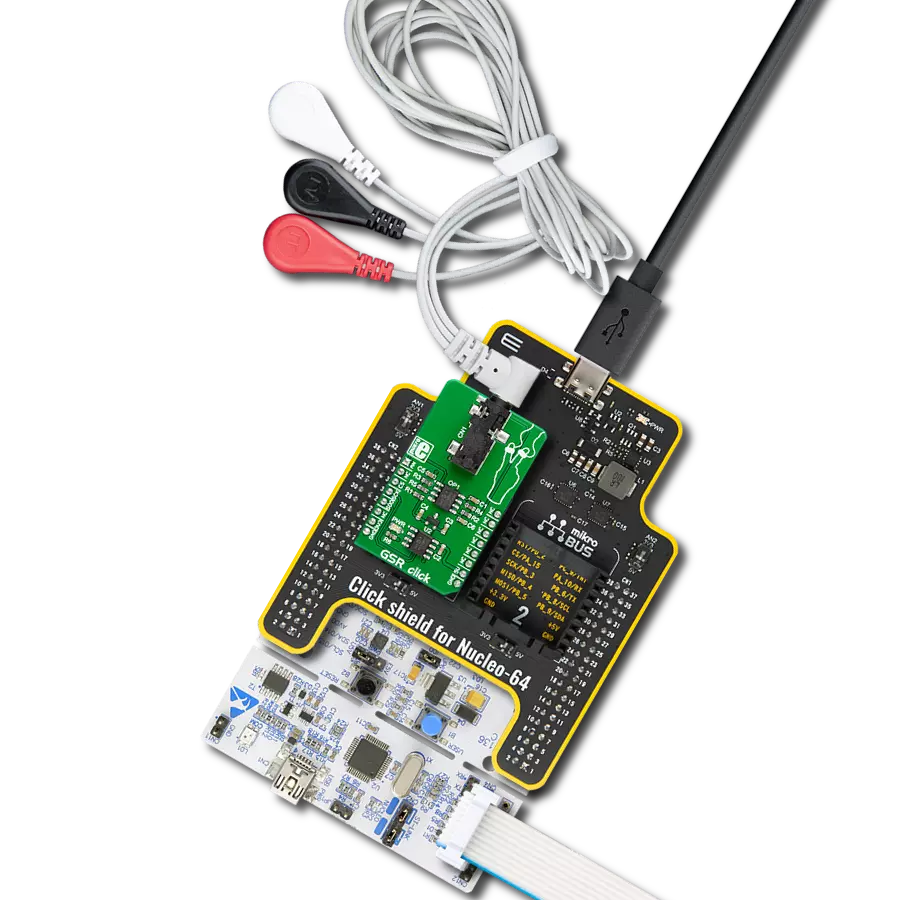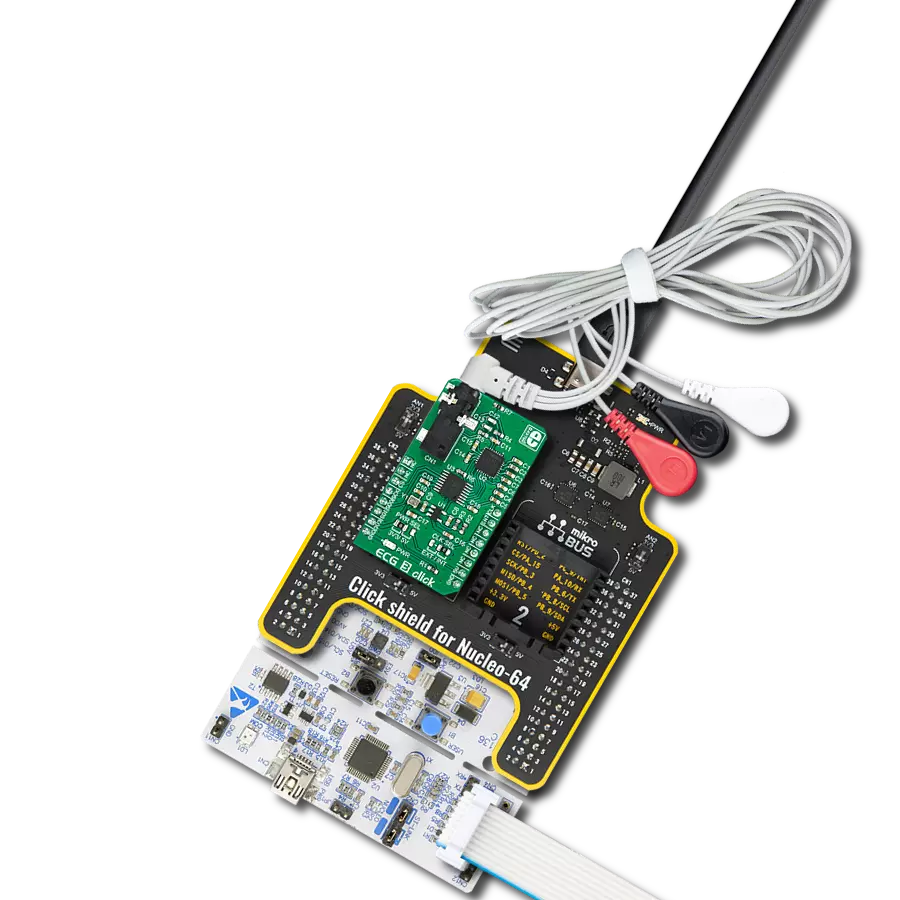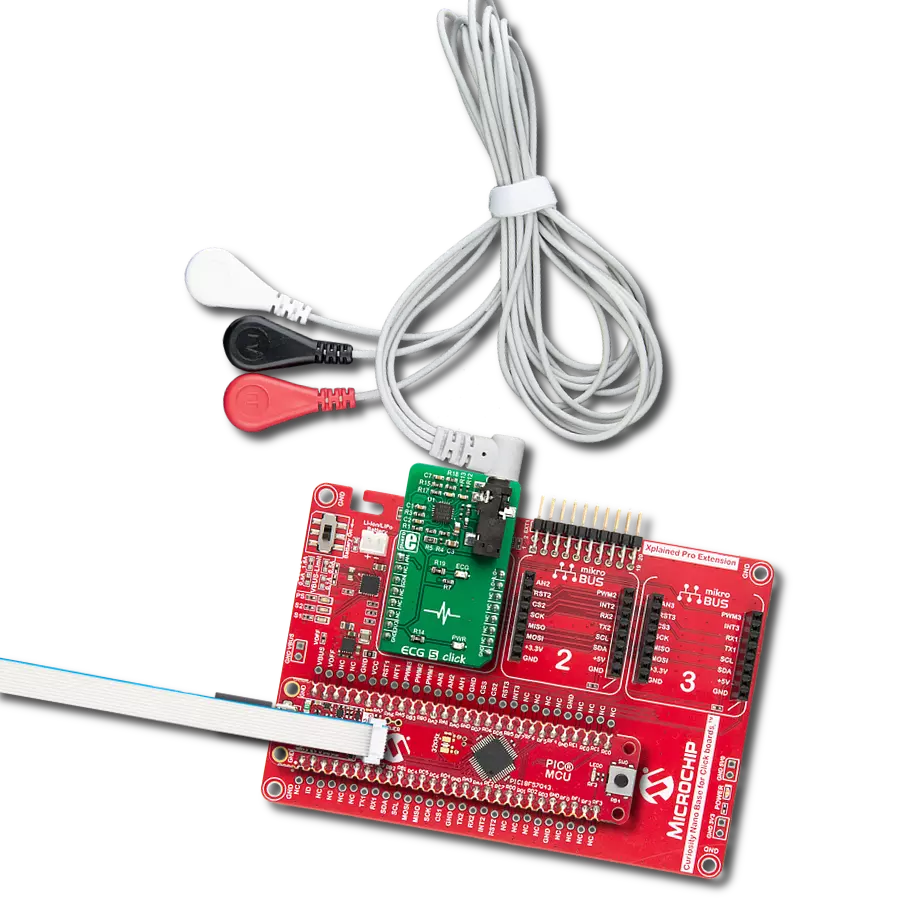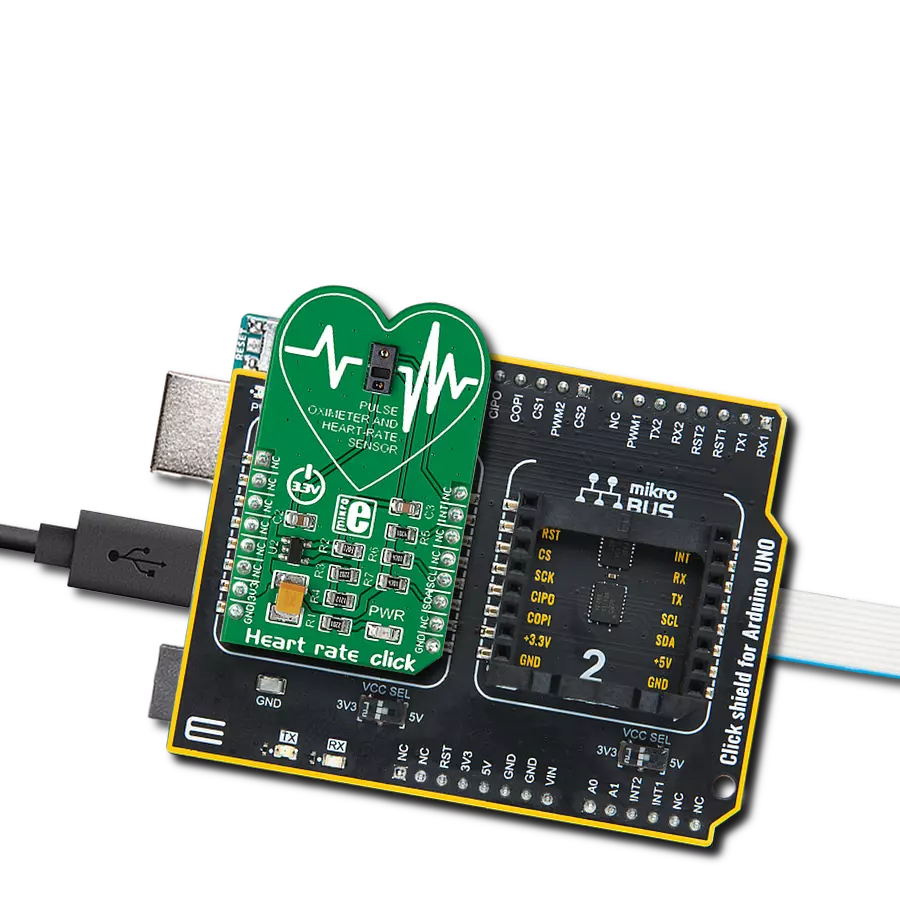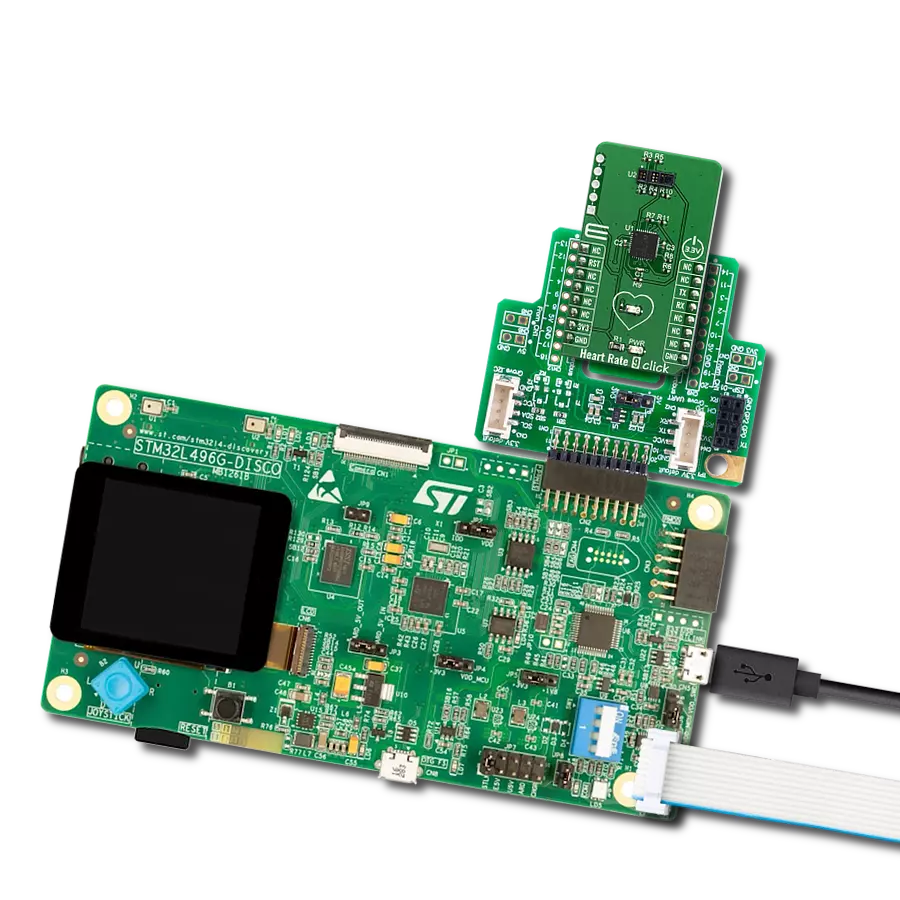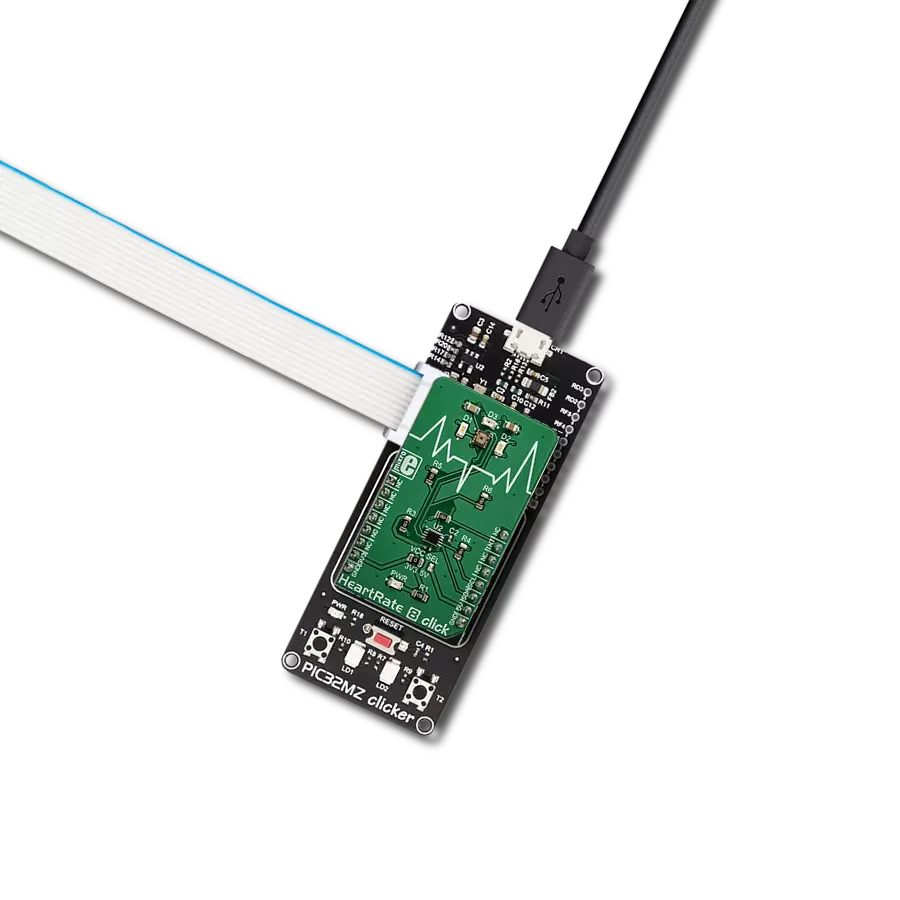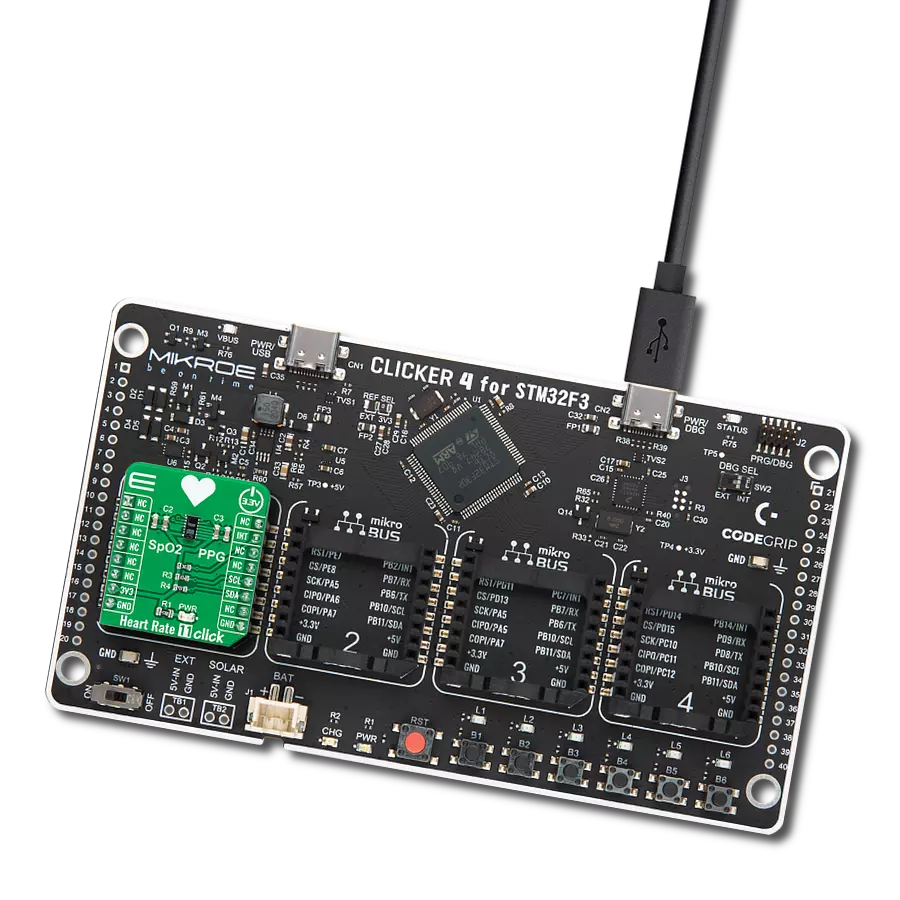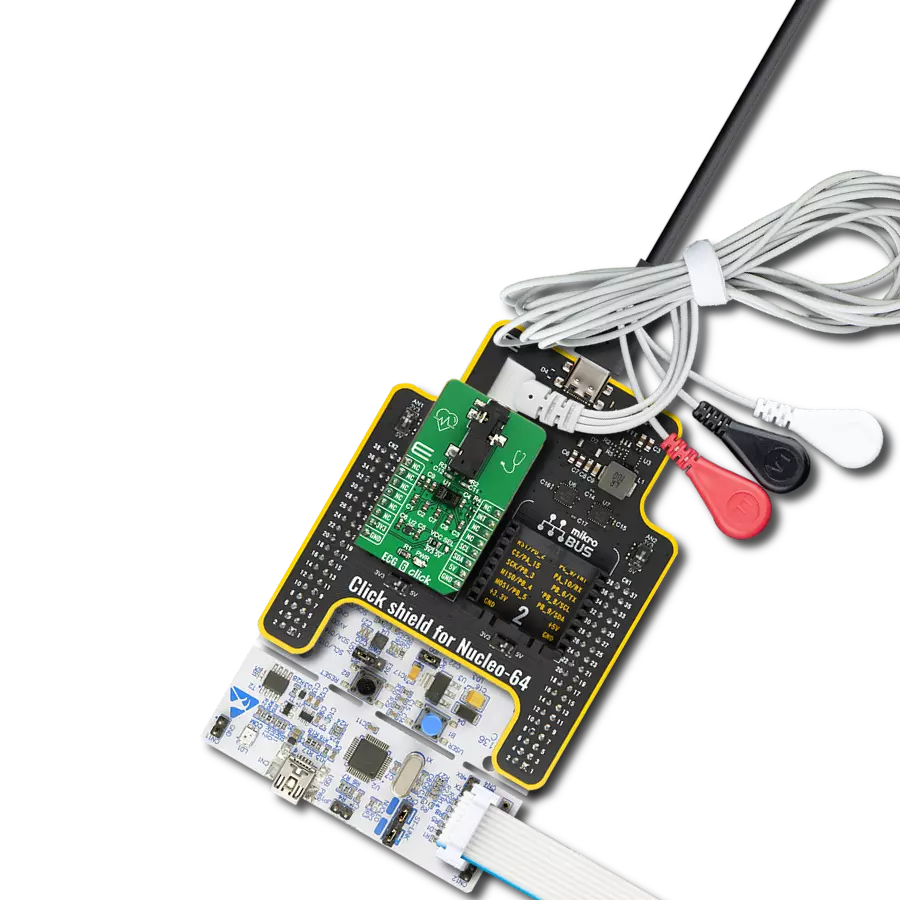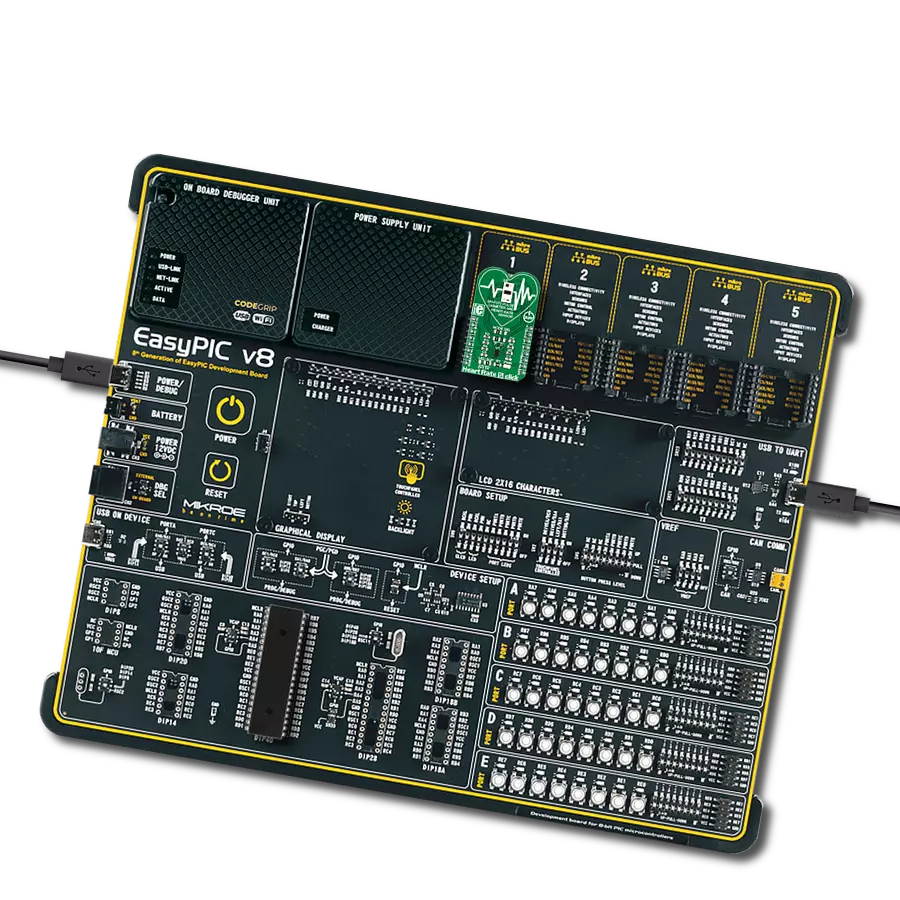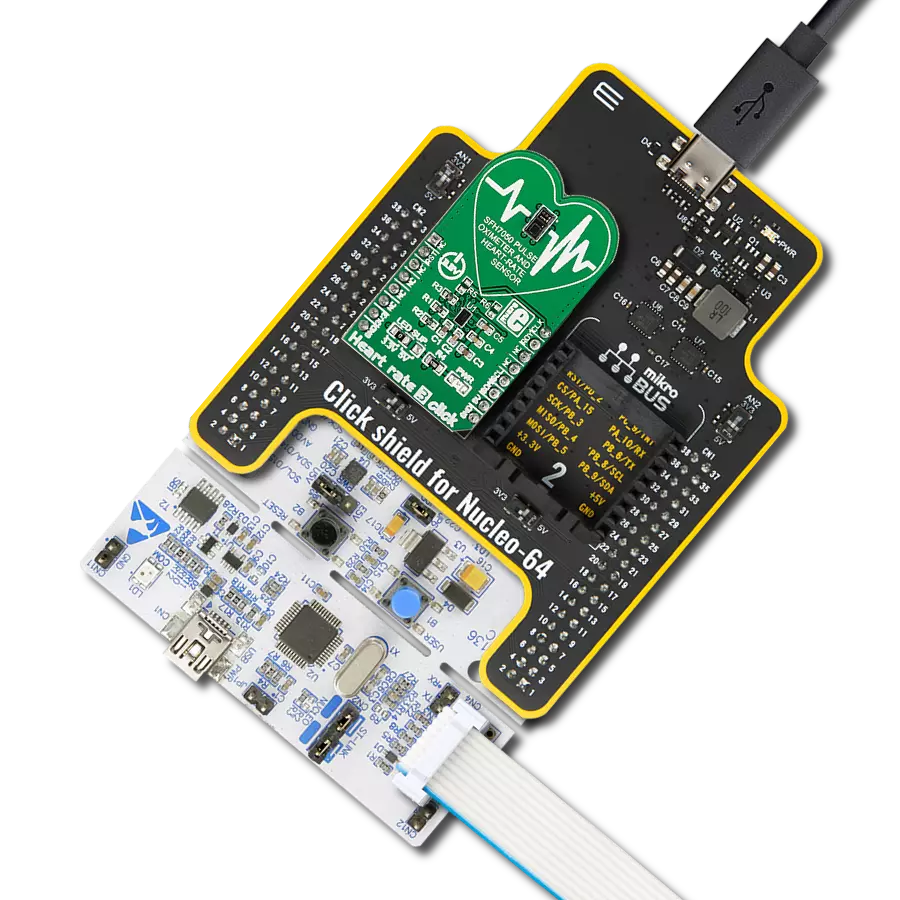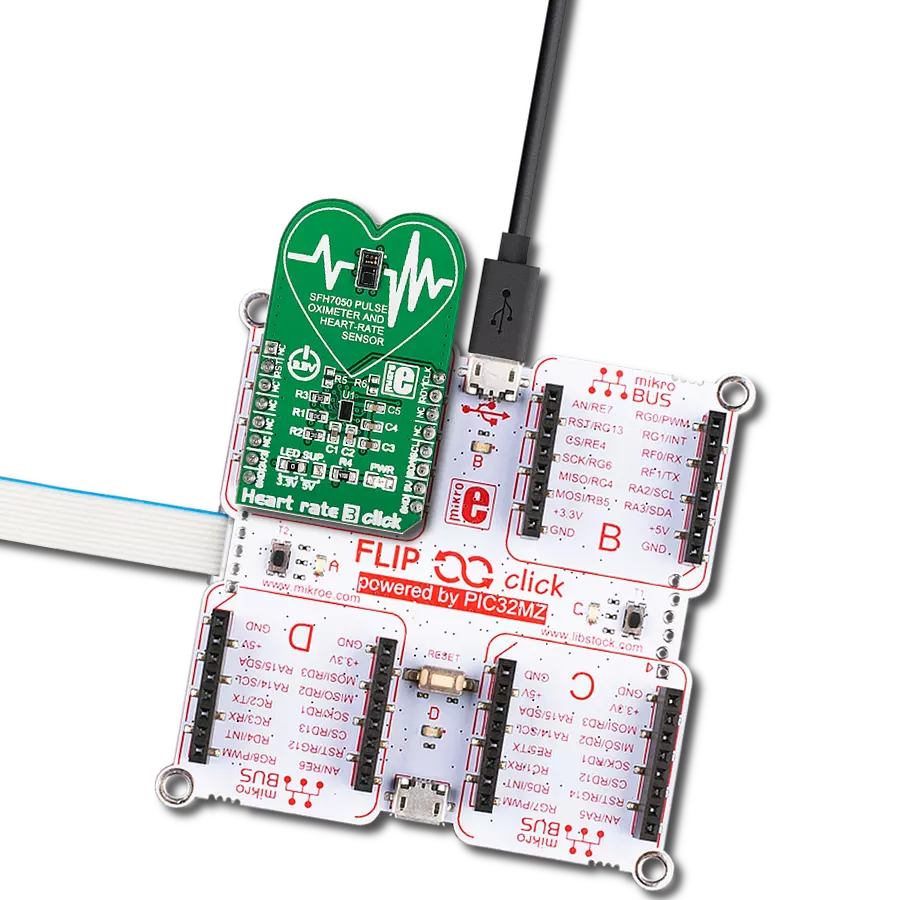Measure the human body's EDA factor, and allow insight into some of the human autonomic nervous system parameters
A
A
Hardware Overview
How does it work?
GSR Click is based on the MCP607, a dual CMOS low-noise OPAMP made by Microchip, and the MCP3201, a 12-bit SAR-type ADC, made by the same company. The input stage consists of the aforementioned voltage divider and a frequency-limiting capacitor. This signal is then fed to the first half of the OPAMP, set to a unity gain. It is used to condition the signal before entering the ADC. The working principle of the GSR click is based on the voltage divider composed of two resistors. One resistor is a fixed resistor 100kΩ (R4), and the second is the human skin, acting as the
variable resistor. DC Voltage is applied to the skin via one electrode, connected to the 3.3V rail. The other electrode closes the electrical circuit through the skin and back to the click board. The voltage at the voltage divider will vary depending on the skin's resistance. The onboard ADC IC uses the SPI for communication with the MCU. The SPI interface pins are routed to the appropriate mikroBUS™ pins. The MCP3201 ADC also needs a clean and stable reference voltage, which the MCP1541, a small, 3-pin specialized reference voltage IC from Microchip, provides. The 5V rail is
routed to the input of the voltage reference, as well as the VCC pin of the ADC IC and the OPAMP IC. This means the Click board™ needs both 3.3V and 5V for proper operation. The other half of the OPAMP is used as the input buffer for the measured signal, and its output is routed to the AN pin of the mikroBUS™. This signal is analog and can be used for either more accurate sampling or for applying some other type of measured signal processing. GSR Click has an onboard 3.5 mm jack used to connect the electrodes to the board securely.
Features overview
Development board
Fusion for TIVA v8 is a development board specially designed for the needs of rapid development of embedded applications. It supports a wide range of microcontrollers, such as different 32-bit ARM® Cortex®-M based MCUs from Texas Instruments, regardless of their number of pins, and a broad set of unique functions, such as the first-ever embedded debugger/programmer over a WiFi network. The development board is well organized and designed so that the end-user has all the necessary elements, such as switches, buttons, indicators, connectors, and others, in one place. Thanks to innovative manufacturing technology, Fusion for TIVA v8 provides a fluid and immersive working experience, allowing access
anywhere and under any circumstances at any time. Each part of the Fusion for TIVA v8 development board contains the components necessary for the most efficient operation of the same board. An advanced integrated CODEGRIP programmer/debugger module offers many valuable programming/debugging options, including support for JTAG, SWD, and SWO Trace (Single Wire Output)), and seamless integration with the Mikroe software environment. Besides, it also includes a clean and regulated power supply module for the development board. It can use a wide range of external power sources, including a battery, an external 12V power supply, and a power source via the USB Type-C (USB-C) connector.
Communication options such as USB-UART, USB HOST/DEVICE, CAN (on the MCU card, if supported), and Ethernet is also included. In addition, it also has the well-established mikroBUS™ standard, a standardized socket for the MCU card (SiBRAIN standard), and two display options for the TFT board line of products and character-based LCD. Fusion for TIVA v8 is an integral part of the Mikroe ecosystem for rapid development. Natively supported by Mikroe software tools, it covers many aspects of prototyping and development thanks to a considerable number of different Click boards™ (over a thousand boards), the number of which is growing every day.
Microcontroller Overview
MCU Card / MCU
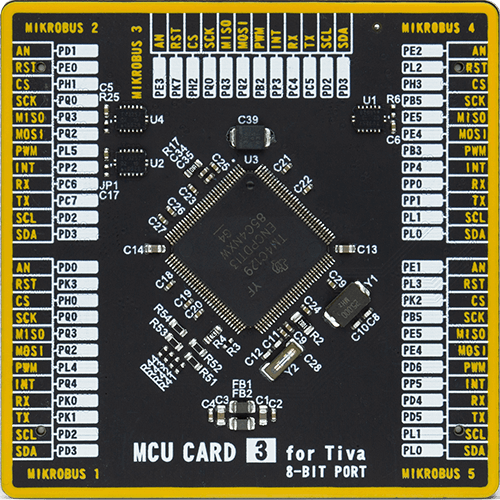
Type
8th Generation
Architecture
ARM Cortex-M4
MCU Memory (KB)
512
Silicon Vendor
Texas Instruments
Pin count
128
RAM (Bytes)
262144
You complete me!
Accessories
3-wire ECG/EMG cable comes with a convenient 3.5mm phone jack, and it is designed for electrocardiogram recording. This 1m cable is a practical companion for medical professionals and enthusiasts. To complement this cable, you can also use single-use adhesive ECG/EMG electrodes measuring 48x34mm, each equipped with an ECG/EMG cable stud adapter. These electrodes ensure a seamless experience when paired with our ECG/EMG cable and guarantee reliable ECG/EMG signal transmission for comprehensive cardiac monitoring. Trust in the accuracy and convenience of this setup to effortlessly record electrocardiograms and electromyograms with confidence.
Used MCU Pins
mikroBUS™ mapper
Take a closer look
Click board™ Schematic

Step by step
Project assembly
Track your results in real time
Application Output
1. Application Output - In Debug mode, the 'Application Output' window enables real-time data monitoring, offering direct insight into execution results. Ensure proper data display by configuring the environment correctly using the provided tutorial.

2. UART Terminal - Use the UART Terminal to monitor data transmission via a USB to UART converter, allowing direct communication between the Click board™ and your development system. Configure the baud rate and other serial settings according to your project's requirements to ensure proper functionality. For step-by-step setup instructions, refer to the provided tutorial.

3. Plot Output - The Plot feature offers a powerful way to visualize real-time sensor data, enabling trend analysis, debugging, and comparison of multiple data points. To set it up correctly, follow the provided tutorial, which includes a step-by-step example of using the Plot feature to display Click board™ readings. To use the Plot feature in your code, use the function: plot(*insert_graph_name*, variable_name);. This is a general format, and it is up to the user to replace 'insert_graph_name' with the actual graph name and 'variable_name' with the parameter to be displayed.

Software Support
Library Description
This library contains API for GSR Click driver.
Key functions:
gsr_read_value- This function read measurement using MCP3201 ADC integrated on GSR Click
Open Source
Code example
The complete application code and a ready-to-use project are available through the NECTO Studio Package Manager for direct installation in the NECTO Studio. The application code can also be found on the MIKROE GitHub account.
/*!
* \file
* \brief Gsr Click example
*
* # Description
* This app measure the electrodermal activity.
*
* The demo application is composed of two sections :
*
* ## Application Init
* Initializes GSR driver.
*
* ## Application Task
* Sequential reading of ADC and logging data
* to UART. Operation is repeated each 500 ms.
*
* \author MikroE Team
*
*/
// ------------------------------------------------------------------- INCLUDES
#include "board.h"
#include "log.h"
#include "gsr.h"
// ------------------------------------------------------------------ VARIABLES
static gsr_t gsr;
static log_t logger;
// ------------------------------------------------------ APPLICATION FUNCTIONS
void application_init ( void )
{
log_cfg_t log_cfg;
gsr_cfg_t cfg;
/**
* Logger initialization.
* Default baud rate: 115200
* Default log level: LOG_LEVEL_DEBUG
* @note If USB_UART_RX and USB_UART_TX
* are defined as HAL_PIN_NC, you will
* need to define them manually for log to work.
* See @b LOG_MAP_USB_UART macro definition for detailed explanation.
*/
LOG_MAP_USB_UART( log_cfg );
log_init( &logger, &log_cfg );
log_info( &logger, "---- Application Init ----\r\n" );
// Click initialization.
gsr_cfg_setup( &cfg );
GSR_MAP_MIKROBUS( cfg, MIKROBUS_1 );
gsr_init( &gsr, &cfg );
}
void application_task ( void )
{
uint16_t adc_value;
adc_value = gsr_read_value( &gsr );
log_printf( &logger, "ADC Measurements: %u \r\n", adc_value );
Delay_ms ( 500 );
}
int main ( void )
{
/* Do not remove this line or clock might not be set correctly. */
#ifdef PREINIT_SUPPORTED
preinit();
#endif
application_init( );
for ( ; ; )
{
application_task( );
}
return 0;
}
// ------------------------------------------------------------------------ END








